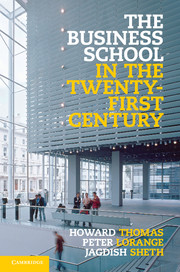Book contents
- Frontmatter
- Contents
- List of figures
- List of tables
- Preface: Tipping or tripping? The business school and its dilemmas
- Acknowledgements
- 1 The business school: history, evolution and the search for legitimacy
- 2 Business school identity and legitimacy: its relationship to the modern university and society
- 3 Rethinking management education and its models: a critical examination of management and management education
- 4 A framework for re-evaluating paradigms of management education
- 5 Evaluating new and innovative models of management education
- 6 Is the business school a professional service firm? Lessons learned
- 7 Enhancing dynamic capabilities in the business school: improving leadership capabilities in curricula and management
- 8 Afterword: business school futures
- Index
- References
5 - Evaluating new and innovative models of management education
Published online by Cambridge University Press: 05 July 2013
- Frontmatter
- Contents
- List of figures
- List of tables
- Preface: Tipping or tripping? The business school and its dilemmas
- Acknowledgements
- 1 The business school: history, evolution and the search for legitimacy
- 2 Business school identity and legitimacy: its relationship to the modern university and society
- 3 Rethinking management education and its models: a critical examination of management and management education
- 4 A framework for re-evaluating paradigms of management education
- 5 Evaluating new and innovative models of management education
- 6 Is the business school a professional service firm? Lessons learned
- 7 Enhancing dynamic capabilities in the business school: improving leadership capabilities in curricula and management
- 8 Afterword: business school futures
- Index
- References
Summary
This chapter is devoted to a critical examination and evaluation of a number of new models and interesting new approaches to management education that have been advocated both by deans (e.g. Richard Lyons at Haas, Berkeley, in the US, and before him Laura Tyson, and Roger Martin at Rotman, Toronto, in Canada) and critics (e.g. Henry Mintzberg at McGill, Montreal, Canada). We believe that the organising framework of Figure 4.4, and Simon’s careful insights, should provide a basis for our model review and analysis of the philosophy underlying each model. Despite the somewhat unfulfilled promise of management education (Thomas, 2012), there has been considerable investment in new business models for its future development.
Indeed, Professors Datar, Garvin and Cullen (2010) provide an exhaustive review of current curricula trends. Prompted by the growing scrutiny of MBA programmes, they started an ambitious and wide-ranging three-year research project on MBA programmes to coincide with the one-hundredth anniversary of Harvard Business School. They examined a range of secondary data sources, interviewed leading business school deans and corporate executives, and outlined clearly the curricula developments at around a dozen leading schools, focusing particularly on programmes at the Center for Creative Leadership, Chicago, Harvard, INSEAD, Stanford and Yale.
- Type
- Chapter
- Information
- The Business School in the Twenty-First CenturyEmergent Challenges and New Business Models, pp. 167 - 196Publisher: Cambridge University PressPrint publication year: 2013

